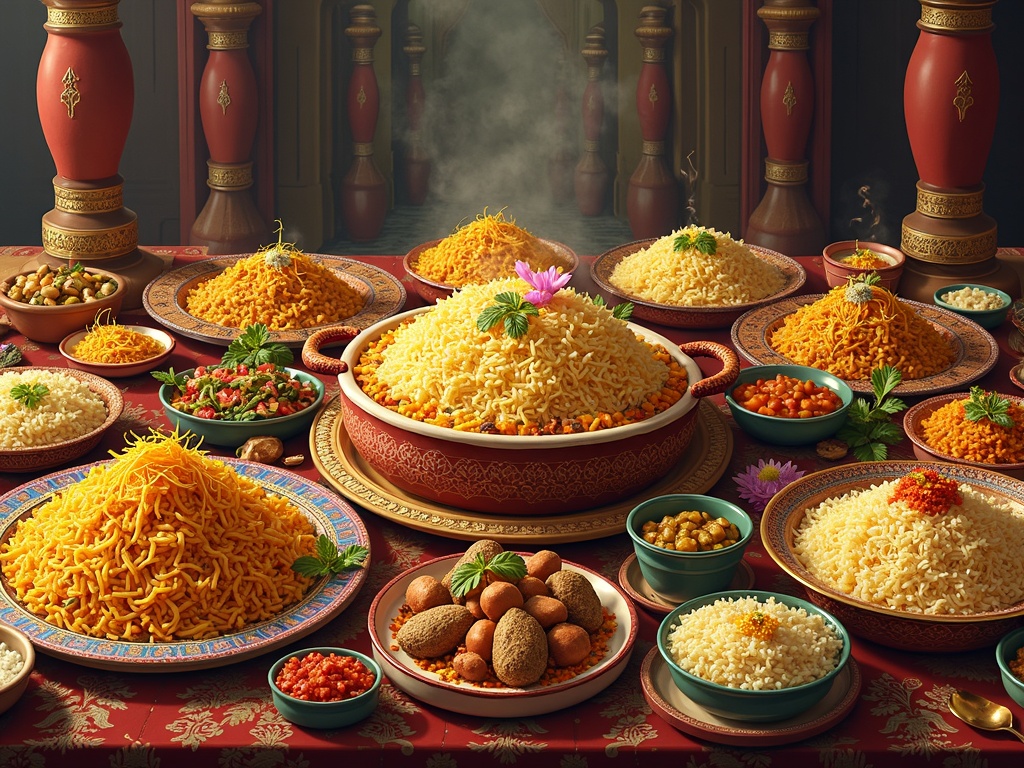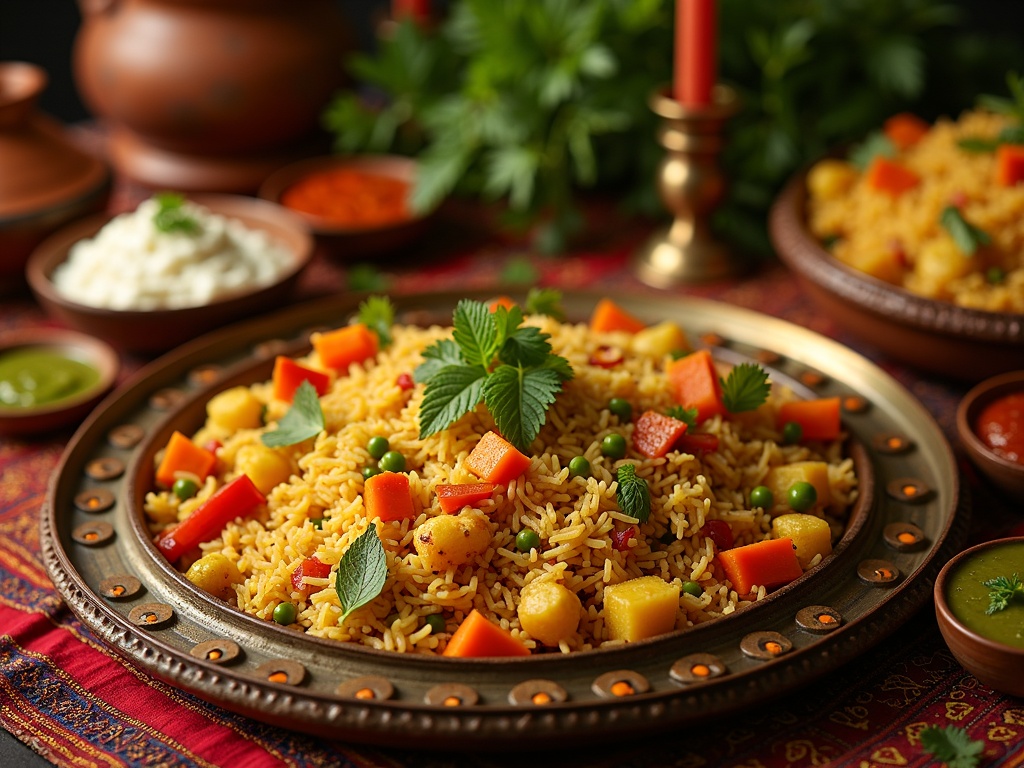Veg biryani evolved from royal Mughal kitchens into a beloved dish that highlights India’s culinary adaptability and regional diversity. The shift from meat-centric royal feasts to vegetarian versions demonstrates how Indian cuisine reinvents traditional dishes while preserving their essence through aromatic spices, layering techniques, and high-quality ingredients.
Find In This Article
Key Takeaways
- Vegetable biryani emerged from the need to accommodate diverse dietary preferences, particularly among Hindu communities with strong vegetarian traditions.
- Regional variations developed distinct characteristics—Hyderabadi biryani uses the “dum” layering technique, Kolkata adds potatoes, and South Indian versions incorporate coconut-infused spices.
- The foundation of perfect veg biryani includes aged basmati rice, colorful vegetables, saffron-infused milk, and a complex blend of whole spices like cardamom, cinnamon, and bay leaves.
- Vegetable biryani accounts for approximately 30% of vegetarian orders in metropolitan Indian restaurants, with its popularity extending globally due to rising interest in plant-based eating.
- Beyond being a delicious meal, biryani serves as a centerpiece for cultural celebrations and special occasions, symbolizing abundance and hospitality while bringing people together.
The Mouthwatering History of India’s Most Famous Rice Dish
The origins of biryani trace back to the lavish kitchens of the Mughal Empire, where it first gained prominence as a royal delicacy. Persian immigrants brought their pilaf techniques to the Indian subcontinent, and this culinary fusion eventually transformed into what we now recognize as biryani. While meat-based versions like chicken biryani initially dominated royal feasts, vegetarian adaptations emerged to accommodate diverse dietary preferences across India.
From Royal Courts to Regional Variations
The journey of biryani across India’s diverse landscape led to fascinating regional adaptations. Each region added its own twist to the basic preparation:
- Hyderabadi Biryani: Known for its distinct layering technique called “dum” cooking, where rice and vegetables are stacked in alternating layers and slow-cooked in a sealed pot. This dum biryani method allows flavors to intensify, creating a harmonious blend of spices.
- Kolkata Biryani: Distinguished by its subtle aromatic qualities and the inclusion of potatoes, this variation developed during the British colonial era when potatoes were introduced to stretch the dish during food shortages.
- Lucknowi Biryani: Characterized by its delicate flavors and mild spicing, this style emphasizes fragrant rice over powerful spice notes.
- South Indian variations: Kerala and Tamil Nadu developed their own versions, often featuring coconut-infused spices and short-grain rice varieties.
I find it fascinating how biryani transformed from a meat-centric dish served in royal courts to a beloved staple across all communities in India. This evolution speaks to the adaptability of Indian cuisine and its genius for reinvention.
The Vegetarian Revolution
The creation of vegetable biryani represents one of the most significant adaptations in the dish’s history. This shift occurred for several reasons:
The strong vegetarian tradition in many parts of India, particularly among Hindu communities, created demand for meat-free alternatives to popular dishes. Innovative cooks discovered that vegetables could absorb the complex biryani spices just as effectively as meat, leading to the development of vegetable curry bases for biryani.
During seasonal religious festivals and fasting periods, vegetarian biryani provided a celebratory dish that adhered to dietary restrictions. Regional ingredients shaped distinct variations – South Indian versions often featured coconut and curry leaves, while North Indian preparations leaned toward heartier vegetables like potatoes and cauliflower.
The vegetarian adaptation also democratized what was once an expensive dish, making it accessible to wider segments of society. Without costly meat, biryani could be prepared in ordinary households, not just royal kitchens or wealthy establishments.
What makes vegetable biryani particularly remarkable is how it maintains the dish’s essential character despite the absence of meat. The careful layering, aromatic spices, and celebration of rice remain intact. The vegetables aren’t merely substitutes but stars in their own right, absorbing the complex flavors of cardamom, cloves, cinnamon, and saffron.
Today, vegetable biryani stands as a testament to Indian cuisine’s remarkable ability to transform and adapt while honoring culinary traditions. Far from being a compromise, it represents an innovation that has secured its place in India’s rich food landscape. The dish continues to evolve, with modern interpretations incorporating ingredients like jackfruit, mushrooms, and paneer to create exciting new variations on this historic recipe.

What Goes Into Perfect Veg Biryani
Creating a flavorful vegetable biryani requires the right combination of ingredients and spices. I’ve spent years perfecting my recipe, and I’ve found that quality ingredients make all the difference in this aromatic dish.
Essential Ingredients and Spices
The foundation of any good veg biryani ingredients starts with long-grain basmati rice. This isn’t just any rice—it’s distinctively aromatic with grains that cook up separate and fluffy rather than sticky. Aged basmati works best as it has less moisture and maintains its structure during the layering and cooking process.
For vegetables, I typically include a colorful mix of:
- Fresh green peas that add pops of sweetness
- Carrots cut into small cubes for color and texture
- Potatoes that absorb the spices and add heartiness
- Cauliflower florets that soak up the flavors beautifully
- Bell peppers for crunch and vitamin C
- Green beans cut into bite-sized pieces
The spice blend is what transforms these simple ingredients into something magical. Saffron threads soaked in warm milk give biryani its signature golden hue and distinctive flavor. Whole spices like cardamom pods, cinnamon sticks, and bay leaves create layers of flavor as they infuse the rice during cooking. These aromatic components are essential for authentic taste—I never skip them when making a traditional biryani recipe of any kind.
I also include a paste of ginger, garlic, and green chilies that forms the flavor base. Fresh herbs like mint and cilantro add brightness, while fried onions contribute sweetness and texture. For creaminess, yogurt is mixed with the vegetables before layering with rice.
The nutritional profile of vegetable biryani makes it a satisfying meal option. A one-cup serving typically contains between 250-300 calories, making it a reasonable main dish. Each serving provides approximately 10 grams of protein, primarily from the rice and any added yogurt or nuts. The fat content hovers around 6 grams, coming from the cooking oil or ghee, while carbohydrates measure about 45 grams per serving.
What makes vegetable biryani particularly valuable nutritionally is its diverse vegetable content. Depending on the vegetables used, you’ll get varying amounts of fiber, vitamins, and minerals. I often add extras like cashews or almonds for protein and healthy fats, plus raisins for natural sweetness.
The spices don’t just add flavor—they offer health benefits too. Turmeric contains curcumin with anti-inflammatory properties. Cardamom aids digestion, while cinnamon helps regulate blood sugar.
For a complete meal, I serve my vegetable biryani with a cooling raita (yogurt sauce) and a side of vegetable curry for additional nutrition and flavor contrast.
The beauty of vegetable biryani lies in its versatility. You can adjust the vegetables seasonally or based on what’s in your pantry. The spice level can be customized to your preference—add more green chilies for heat or remove them entirely for a milder version.
When prepared correctly with quality ingredients, vegetable biryani offers a perfect balance of flavors, textures, and nutrition. It’s a one-pot meal that satisfies all senses while providing substantial nourishment.
Master the Art of Biryani Making
Creating a perfect vegetable biryani requires understanding the cooking techniques that bring out its authentic flavors. I’ve found that mastering the cooking method is just as important as selecting the right ingredients when making this aromatic dish.
Dum vs Pressure Cooker: Choosing Your Technique
The traditional dum biryani method involves slow-cooking in a sealed pot, allowing flavors to develop gradually. In this technique, I layer partially cooked rice with marinated vegetables, seal the pot with dough, and cook on low heat. This slow-cooking approach preserves delicate flavors and creates distinct layers where each grain of rice remains separate yet infused with spices.
The pressure cooker method, on the other hand, speeds up the cooking process significantly. While convenient for busy weeknights, it often results in a more homogenized flavor profile. The pressurized environment forces flavors to mix more thoroughly, creating a different but equally delicious result.
Slow-cooking through the dum method actually helps retain more nutrients in vegetables. The gentle heat breaks down cell walls without destroying vitamins, particularly water-soluble ones like B and C. Research from food science studies shows that prolonged exposure to lower temperatures can preserve up to 90% of certain nutrients compared to rapid high-heat cooking.
Perfect Your Biryani Technique
For the best results with vegetable biryani, follow these timing guidelines:
- Rice pre-cooking: Parboil basmati rice for exactly 5-7 minutes until it’s 70% cooked
- Vegetable marination: Allow vegetables to marinate for at least 30 minutes, preferably 2 hours
- Dum cooking time: 20-25 minutes on low heat after sealing
- Resting period: Let biryani stand unopened for 10 minutes after cooking
Enhancing vegetable flavors starts with proper marination. I’ve discovered that yogurt-based marinades work wonderfully for vegetable curry components in biryani. Adding freshly ground spices rather than pre-ground ones makes a noticeable difference. For extra depth, try roasting spices before grinding.
Layering is crucial for authentic biryani. Begin with a base of marinated vegetables, followed by partially cooked rice. Sprinkle each rice layer with saffron-infused milk, fried onions, and mint leaves. This careful layering, combined with proper dum cooking, creates the distinctive flavor separation that sets great biryani recipes apart from ordinary rice dishes.
For the perfect finish, I always drizzle ghee infused with whole spices around the edges of the pot before sealing. This creates aromatic steam that permeates the entire dish during the dum cooking process, resulting in a biryani that delights all the senses.
Why Veg Biryani Rules Indian Restaurants
Vegetable biryani has firmly established itself as a cornerstone of Indian restaurant menus, both in India and internationally. I’ve noticed its unmistakable presence on nearly every Indian restaurant menu I visit, regardless of region or specialization.
Restaurant Dominance and Statistics
Vegetable biryani accounts for approximately 30% of all vegetarian orders in metropolitan Indian restaurants. This impressive statistic showcases just how beloved this aromatic rice dish has become among diners seeking meat-free options. The dish strikes a perfect balance between heartiness and flavor complexity, making it an ideal choice for both vegetarians and those occasionally opting for plant-based meals.
The popularity extends beyond just traditional Indian establishments. Fast-casual dining spots, food trucks, and even non-Indian fusion restaurants have begun incorporating vegetable dum biryani onto their menus, recognizing its universal appeal and profitability.
Global Appeal and Social Media Influence
I’ve witnessed vegetable biryani’s international popularity soar in recent years. What was once considered a secondary option to its meat counterparts has evolved into a standout dish that many specifically seek out. This shift can be attributed to several factors:
- Increasing global interest in plant-based eating and sustainability
- Growing appreciation for complex vegetarian cuisine beyond simple side dishes
- Cultural exchange through travel and immigration exposing more people to authentic Indian flavors
- Rising health consciousness and the nutritional balance biryani offers
Social media has played a tremendous role in popularizing vegetable curry dishes like biryani. Visually striking with its vibrant colors and layered presentation, veg biryani makes for perfect Instagram content. Food influencers frequently showcase elaborate biryani preparations, driving curious diners to restaurants to experience the dish themselves.
Restaurant owners have capitalized on this trend by creating signature vegetable biryani variations that set them apart from competitors. Some establish their reputation on particularly authentic regional styles, while others innovate with fusion elements or premium ingredients like saffron and exotic vegetables.
The growing popularity of chicken biryani has also inadvertently boosted its vegetarian cousin, as restaurants develop equally impressive plant-based alternatives to satisfy all customer preferences.
Celebrating Special Moments with Biryani
Biryani isn’t just a meal—it’s the centerpiece of countless celebrations across South Asian cultures. I’ve witnessed how this aromatic dish transforms ordinary gatherings into memorable feasts, especially during significant life events and religious festivities.
Biryani’s Central Role in Cultural Celebrations
In wedding ceremonies throughout India, Pakistan, and Bangladesh, vegetable biryani often takes center stage as the showstopper dish. The fragrant rice layered with spiced vegetables symbolizes abundance and prosperity for the newlyweds. During Eid celebrations, families gather around steaming pots of fragrant dum biryani to break their fast together, strengthening community bonds.
Recent trends show a 25% increase in biryani-themed events over the past five years, highlighting its growing popularity beyond traditional settings. This rise reflects how deeply biryani has become embedded in the cultural fabric of celebrations.
The cultural significance of biryani extends across diverse communities:
- In Hyderabadi traditions, serving biryani signifies hospitality and respect for guests
- Bengali celebrations often feature lighter, more delicately spiced versions
- Kashmiri festivals incorporate local ingredients like saffron and dried fruits
- South Indian celebrations might include coconut-infused varieties
Modern Interpretations for Contemporary Celebrations
Today’s celebrations have given rise to creative adaptations of traditional biryani. I’ve seen everything from biryani stations at wedding receptions to biryani-inspired canapés at corporate events. Chefs are experimenting with presentation while maintaining authentic flavors.
The versatility of vegetable curry components in biryani makes it perfect for today’s diverse dietary preferences. Modern celebrations often feature both traditional chicken biryani recipes alongside innovative vegetarian versions.
What makes biryani particularly special for celebrations is its communal nature. The large pots encourage sharing, conversation, and connection—essential elements for any meaningful gathering. Whether served at lavish wedding banquets or intimate family reunions, biryani creates a shared experience that transcends cultural boundaries.
For those planning significant celebrations, incorporating biryani honors tradition while satisfying contemporary tastes. The dish’s visual appeal, aromatic presence, and rich flavors combine to create not just a meal, but a memorable experience that guests associate with your special occasion.

Sources:
Culinary Traditions of India: A Historical Perspective
Nutritional Analysis of Indian Cuisine: Biryani Variants
Trends in Indian Dining: The Rise of Vegetarian Dishes
Cultural Insights: Food and Celebrations in India
Survey Report 2022: Vegetarian Preferences in Urban India

